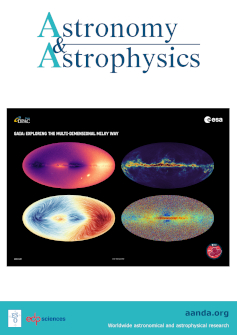测量不确定度对卫星星系平面推断稳定性的影响
IF 5.4
2区 物理与天体物理
Q1 ASTRONOMY & ASTROPHYSICS
引用次数: 0
摘要
上下文。观测表明,银河系、仙女座星系、半人马座A星系,以及可能的其他星系都有空间薄且运动一致的卫星平面。这种结构在标准的ΛCDM宇宙学模型中是极不可能的,而且这些平面的动力学稳定性一直存在争议。准确地确定它们的稳定性需要彻底了解轨道参数,如正常运动、距离和视线速度,以及宿主星系的引力势。然而,许多这些参数仍然缺乏约束,导致分析中的重大不确定性。本研究探讨了卫星星系固有运动和距离的测量误差以及所采用的主晕质量对类银河系势场中卫星平面推断稳定性的影响。我们通过添加不同程度和类型的观测误差来模拟绕宿主星系运行的模拟观测测试卫星星系,然后对轨道进行反向整合。我们分析了初始条件和应用于卫星系统轨道稳定性推断的不确定性之间的趋势和相关性。我们还考虑了采用不正确电位的影响和不同轨道偏心率的影响。固有运动的不确定性导致固有稳定卫星平面明显变宽,其宽度随所采用固有运动的不确定性线性增加。即使在盖亚系统层面上的不确定性也会强烈地影响平面过去推断的宽度。此外,具有低晕质量的势对这些面的稳定性有显著影响,而其余两种主模型显示出类似的影响。卫星距离的不确定性也显著影响了推断的不稳定性。本文章由计算机程序翻译,如有差异,请以英文原文为准。
The effect of measurement uncertainties on the inferred stability of planes of satellite galaxies
Context. Observations have revealed that the Milky Way, Andromeda, Centaurus A, and possibly other galaxies host spatially thin and kinematically coherent planes of satellites. Such structures are highly improbable within the standard ΛCDM cosmological model, and the dynamical stability of these planes has long been debated. Accurately determining their stability requires a thorough understanding of orbital parameters such as proper motion, distance, and line-of-sight velocity, in addition to as the gravitational potential of the host galaxy. However, many of these parameters remain poorly constrained, leading to significant uncertainties in analyses.Aims. This study explores the impact of measurement errors in the proper motions and distances of the satellite galaxies and in the adopted host halo mass on the inferred stability of satellite planes in Milky Way-like potentials.Methods. We simulated mock-observed test satellite galaxies orbiting a host galaxy by adding various degrees and types of observational errors, and then backward-integrated the orbits. We analyzed trends and correlations between the initial conditions and the uncertainties applied on the inferred orbital stability of the satellite systems. We also considered the effects of adopting incorrect potentials and the impact of different orbital eccentricities.Results. Uncertainties in proper motions lead to an apparent widening of an intrinsically stable satellite plane, with its width increasing linearly with the uncertainties in the adopted proper motion. Even uncertainties at the level of Gaia systematics strongly affect the plane’s inferred past width. Moreover, the potential with a low halo mass has a significant impact on the stability of these planes, whereas the remaining two host models show similar effects. Uncertainties in satellite distance also contribute noticeably to the inferred instability.
求助全文
通过发布文献求助,成功后即可免费获取论文全文。
去求助
来源期刊

Astronomy & Astrophysics
地学天文-天文与天体物理
CiteScore
10.20
自引率
27.70%
发文量
2105
审稿时长
1-2 weeks
期刊介绍:
Astronomy & Astrophysics is an international Journal that publishes papers on all aspects of astronomy and astrophysics (theoretical, observational, and instrumental) independently of the techniques used to obtain the results.
 求助内容:
求助内容: 应助结果提醒方式:
应助结果提醒方式:


